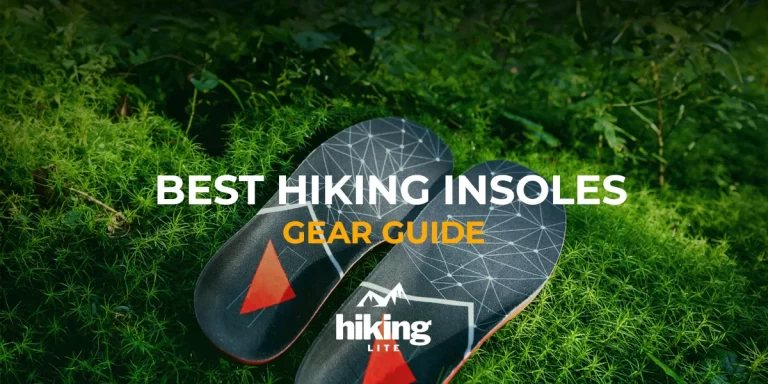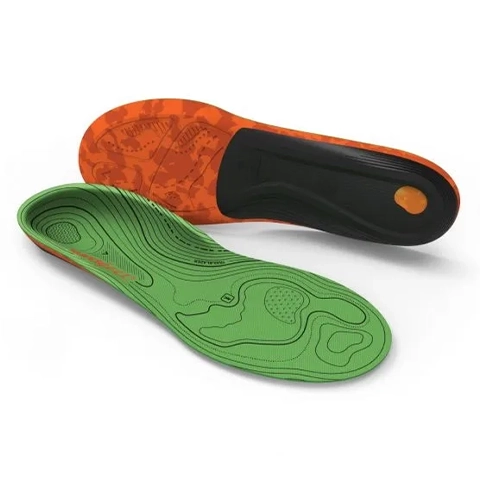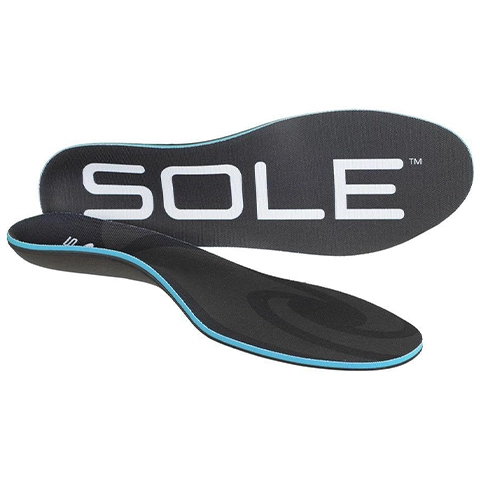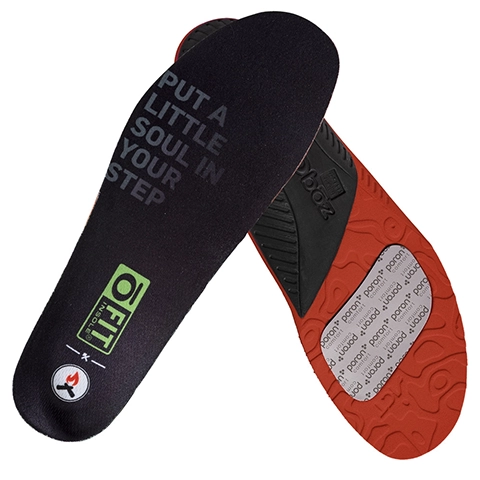

When selecting hiking insoles, keep in mind the importance of comfort, arch support, cushioning, moisture-wicking properties, durability, and compatibility with your footwear.
Achieving a balance between weight and performance is key for an enhanced hiking experience.
Be cautious, however, as making the wrong choice could lead to discomfort, inadequate support, blisters, or even potential foot injuries.
Thankfully, our guide is here to help you make an informed decision that suits your requirements.

Key Specs
Weight: 2.96 ounces (84 grams)
Price: $$
PROS
✅ Ultralight
✅ Good moisture control
CONS
❌ Not enough structural support
As someone constantly looking to optimize my hiking and backpacking setup, I was interested in trying the Currex HikePro insoles due to their ultralight design. Their marketed benefits of blister protection and moisture wicking seemed handy for long miles on the trail.
However, after using them on some day hikes and short overnight trips, I found they did not provide the firm structural support my feet prefer. Compared to others I’ve used previously, the flexible HikePro design allowed more pronation than works well for my foot type.
For casual day hiking their lighter profile may suit some, but serious terrain requires maximum cushioning and control.
While well-constructed, they were not the best match for the rigors of my preferred trail adventures. While versatile, some users may find a more substantial design better tailored to their needs and activity levels. Fit and performance depend greatly on individual biomechanics and intended usage.
Overall the HikePros seem suited mainly to less rugged day hiking. But for backpacking over varied terrain, a more supportive option may better serve those seeking optimal protection on extended trips.

Key Specs
Weight: 3.67 ounces (104 grams)
Price: $$
PROS
✅ Don’t require breaking in
✅ Comfortable
CONS
❌ Moderate support for some
As an avid hiker getting on in years, foot fatigue and pain have become more of an issue. Within just a few uses, the Superfeet Hike Cushion Insoles havenoticeably extended my comfortable hiking distance before feet start to protest. I can now go several extra miles before needing to rest my feet.
Additionally, I no longer experience bothersome metatarsal pain even on rock-strewn routes. The arch support and cushioning absorb shock exceptionally well. After breaking them in over a couple weeks, I’ve been virtually pain-free on varied terrain that used to aggravate my feet.
While the provided support suits my moderately-arched feet well, those with very high arches may find the level of support on the lighter side. However, for average to low arches like mine, the stabilizing comfort has made a tremendous difference in alleviating and preventing fatigue.
Overall, if footwear upgrades can save a hike, these insoles are an invaluable addition for serious hikers seeking maximum resilience over lengthy missions in the wilds.

Key Specs
Weight: 3.77 ounces (107 grams)
Price: $$
PROS
✅ Good quality
✅ Deep heel pocket
CONS
❌ Some experience foot slip
The Superfeet TRAILBLAZER Comfort insoles are a good option for hikers looking for extra support and cushioning on uneven trails.
These insoles have a deep heel cup to keep your foot stable and an arch support area for comfort. They are made to last up to 12 months or 500 miles of hiking.
The foam cushioning in these socks absorbs shock and impact, which can lessen foot pain and tiredness, especially when hiking with a backpack or on rough terrain all day. They’re made to fit most hiking boots and shoes.
Some hikers say the insoles made their feet slip around in their boots. So that’s something to consider when deciding if these are right for your hiking needs.
Overall, the TRAILBLAZER Comfort insoles offer useful features for trail comfort at a reasonable price.

Key Specs
Weight: 3.95 ounces (112 grams)
Price: $$$
PROS
✅ Good arch support
✅ Heat/wear moldable
CONS
❌ Modest cushion
❌ Heat molding requires some skill
The Sole EVA footbed absorbs shock and cushions your feet during hikes. Its strong EVA foam can endure heavy use and impacts from activities like hiking with a heavy pack, making it ideal for long hikes over rough terrain.
Many hikers say these insoles provide satisfying comfort on the trails. However, some users felt the cushioning could be improved more.
An issue is that the footbed is quite thick. This makes it hard to trim to fit your boots and it takes up space in your shoes.
To customize the arch support, you can heat mold the footbed. But the instructions to heat it in the oven for 2 minutes did not work well. Using a hair dryer up close heated it better to reshape the arch area.
Still, it’s a great option if you want a fully customized solution to fit your feet perfectly.

Key Specs
Weight: 4 ounces (113 grams)
Price: $$
PROS
✅ Relatively affordable
✅ Great odor control
CONS
❌ Moderate arch support
❌ Some durability concerns
The Oboz insoles use Poron foam to help reduce foot fatigue. They also have arch support and odor control. After using them for about a week, I find these insoles strike a good balance between thin basic insoles and rigid ones like SuperFeet.
The Oboz insoles have a deep heel cup but the arch is flexible to fit different shoes.
The edges are smooth and don’t cut boot linings which can happen with some insoles. For keeping feet warm, these are awesome. I have cold feet but these regulate temperature well without overheating.
One concern is the reflective coating seems to wear off where there is friction. After a week, about 20% has rubbed off in high friction areas. This may affect warmth over time as more coating wears off.
The odor control works great but some may want more arch support. The Oboz insoles provide good cushioning and temperature regulation at a reasonable price point for lightweight hikers. But the coating durability is uncertain long term.
Choosing the right hiking insoles is crucial for hikers seeking comfort and support on long treks.
The insoles we’re discussing in this guide fall into the categories of “support” or “sport” insoles.
These insoles are made from a firmer material, which provides structural support and stability. Instead of relying on direct cushioning for comfort, they enhance comfort by offering greater stability. This sets them apart from the softer, more cushiony insoles commonly found in supermarkets.
Insoles come in different various arch shapes:
Also don’t forget to regularly inspect your insoles as quality ones can last 300 to 500 miles.
Most quality hiking insoles are built to be long-lasting through extensive use on the trails. However, expect to replace them about every 12 months or 500 miles hiked, whichever comes first. The cushioning and support materials compress over time and lose effectiveness. Also, accumulated dirt and microbes from sweat can affect function and lead to unpleasant odors. Replacing insoles regularly helps maintain proper arch support, impact absorption and foot stabilization. This protects from injury while extending comfortable miles on the trails. Investing in new inserts yearly ensures your feet stay happy and hiking strong.
When you get new hiking insoles, try them out on short, simple hikes first. This helps your feet get used to them before you go on longer hikes. Before hitting the trails, wear them at home with socks to help them mold to your feet better. The materials in the insoles will squish down and shape to your feet more over the first few weeks of use. When you start hiking with them, don’t go too far at first. Just do a few miles to give your feet time to get used to the new support and avoid getting blisters. Also, keep in mind that thick insoles might make your shoes feel tighter, so you might need to get a bigger size.
Hiking insole orthotics insert into shoes to help support and cushion the feet. They provide arch support, heel stabilization, and shock absorption for impact on rugged trails. Breathable materials keep feet cool while wicking away moisture. This helps prevent blisters while hiking long distances with heavy packs. The customized arch and heel support also aids stability on uneven ground, reducing strain on feet, ankles and knees. Overall, inserts optimize comfort and endurance for avid hikers.